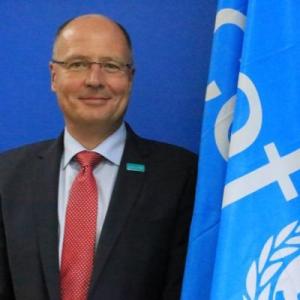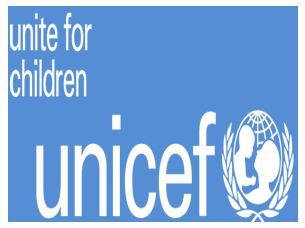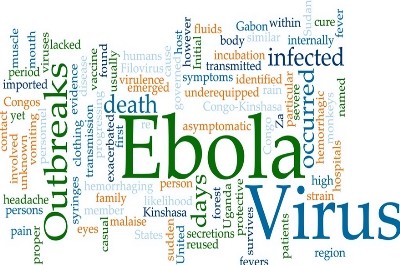UN press briefing in Geneva – excerpts on Ebola
REGULAR PRESS BRIEFING BY THE INFORMATION SERVICE
30 September 2014 – Corinne Momal-Vanian, Director of the United Nations Information Service in Geneva, chaired the briefing, which was attended by representatives of the Office for the Coordination of Humanitarian Affairs, United Nations Children’s Fund, United Nations Conference on Trade and Development, United Nations Environment Programme, United Nations Refugee Agency, World Food Programme and the World Health Organization.
Ebola Response
Christophe Boulierac, for the United Nations Children’s Fund (UNICEF), introduced his UNICEF colleague Manuel Fontaine, Regional Director for West and Central Africa. Speaking via audio link from Dakar, Senegal, Mr. Fontaine briefed journalists on his recent mission to Liberia. UNICEF was a major actor and strongly involved in the Ebola response, he said, noting that it had so far conducted 50 airlifts to the three countries delivering approximately 550 metric tonnes of supplies. Mr. Fontaine said he had been on mission to Liberia to look at UNICEF’s capacity, see what the main issues were and understand what UNICEF could be doing better.
The immediate and important issues on the ground were the lack of treatment capacity and the need to break the cycle of transmission. However, the side effects of the Ebola crisis required more focus as they were becoming increasingly acute, said Mr. Fontaine. One side effect was the indirect impact the Ebola crisis was having on other health issues such as malaria or acute diarrhoea. In most cases, access to treatment and services were not available. A second issue was the impact of the crisis on child protection, said Mr. Fontaine. UNICEF estimated that there were approximately 3,700 children who had been orphaned because of Ebola, either by the deaths of one or both parents, across Liberia, Sierra Leone and Guinea. That figure was probably the tip of the iceberg.
There were several categories of children who needed to be cared for, said Mr. Fontaine, and the first was the orphans. A second category was children who were potentially orphans but had disappeared, for example children whose parents had brought them to the Ebola Treatment Unit (ETU) then died; no information was taken about their children who were now difficult to trace.
Third, there was the issue of caring for children who had been in contact with their parents or had been sick with Ebola themselves and were now survivors, and who now bore very strong stigma in their communities. UNICEF was considering whether the children should be isolated for the 21 days following exposure, and if so where and who could care for them. The UNICEF preference was always to find alternative family care but that was very difficult for infection reasons, especially in the 21 days following exposure. An alternative possibility was establishing interim care centres and UNICEF was looking at doing that in Liberia and Sierra Leone, and potentially Guinea, to find care for children at least for the 21 day period.
In that regard the biggest issues were stigma, the risk to social cohesion and of communities collapsing said Mr. Fontaine. UNICEF was trying to find survivors, those who had been sick with Ebola, recovered and were now immune, who may be able to care for the children. The authorities in Liberia were very worried about the issue as an increasing number of children were being left alone in their homes, they may be being fed by neighbours, but were receiving no more care than that. It was an advantage that Liberia and Sierra Leone had fairly advanced legal systems to care for children because of the wars, he noted.
UNICEF planned to hold a Survivor’s Conference in Sierra Leone in October to work out what role survivors could potentially play in caring for the children, whether in Ebola Treatment Units or interim care centres or elsewhere, said Mr. Fontaine.
Answering a question about how many children had been infected with Ebola, Mr. Fontaine said the WHO estimated that 15 per cent of all patients who had died from Ebola were younger than 15 years. The percentage of children infected was proportionally lower to the number of children in the community, mostly because the children were not usually primary caregivers. Most of the people being infected were health care workers and other people who had had direct contact with Ebola patients.
WHO and UNICEF were realizing that there was no clear protocol for children in Ebola Treatment Units (ETUs) or for infected children, said Mr. Fontaine. For example, a five-year old child infected with Ebola and placed in an ETU would be very isolated and in a very rough and difficult environment, they wouldn’t be able to have a constant care-giver to help them. Some parents asked other patients in ETUs and infected areas to look out for their children, and staff tried to help as well. The work carried out by ETU staff was amazing, added Mr. Fontaine, they weren’t just carrying body bags but they were caring for people. However, staff couldn’t wear the protective equipment for more than one hour at a time so it was really hard to care for children. A way forward could be the establishment of children’s wards in ETUs. Responding to questions about what services were already in place for Ebola orphans Mr. Fontaine replied that there were small units in Liberia that could accommodate 10 to 15 child survivors each, but more such units were needed in all three countries.
Mr. Fontaine made a clarification to confirm that the Survivor’s Conference planned for Sierra Leone was being organized jointly by the Ministry of Social Welfare of Sierra Leone and UNICEF. He also clarified that a figure of 2,500 survivors represented a projection of survivors over the next few months that UNICEF hoped to work with – not the number of survivors today.
Jens Laerke, for the Office for the Coordination of Humanitarian Affairs (OCHA), said OCHA’s Financial Tracking Service had begun tracking the funding to the Ebola virus disease outbreak response in West Africa, against the five strategic objectives in the recently presented Overview of Needs and Requirements from September 2014 to February 2015. To date 25.7 per cent of the total funding requirement of US$988 million identified in the Overview had been received, equalling US$254 million, said Mr. Laerke. The funding was divided between five strategic objectives: stop the outbreak; treat the infected; ensure essential services; preserve stability; and prevent outbreaks in countries currently unaffected.
Elisabeth Byrs, for the World Food Programme (WFP), said WFP had delivered almost 5,000 metric tonnes of food for more than 380,000 people in the three most affected countries (Guinea, Liberia and Sierra Leone) under its emergency operation as of 26 August. Through WFP’s Logistics Augmentation and common services Special Operation, WFP provided urgently needed specialised equipment, transport and storage of relief cargo at strategic locations, logistics cluster coordination and emergency telecommunications.
So far, WFP had transported over 900 cubic metres of cargo, including personal protective equipment, thermometers and chlorine, on behalf of partners and 615 cubic metres of vital supplies had been stored. In Liberia, WFP had established a centralised logistics hub in Monrovia in order to manage, dispatch and track required health stocks. The Common Hub, which became operational on 25 September, had over 700 cubic metres of storage capacity.
Ms. Byrs also informed the media that WFP had contracted a ship for the Ebola response. The ship was currently in Cotonou where it would be loaded with 7,000 metric tonnes of rice, to be transported to Monrovia, Liberia, and Freetown, Sierra Leone.
Ms. Byrs also spoke about the Humanitarian Air Service (UNHAS) that facilitated the movement of humanitarian workers and the delivery of light cargo between and within the three affected countries, which was managed by WFP. As of 25 September, UNHAS had transported 426 passengers and approximately 6.6 metric tonnes of light cargo for 25 organisations (including non-governmental organizations, United Nations organizations, donors, Government partners and media).
Furthermore, the humanitarian community had been given three months approval for a humanitarian air-bridge between Dakar, Senegal and the three affected countries. Construction of the humanitarian passenger terminal at Dakar Airport was complete and the first UNHAS flight took place on 25 September from Dakar to Conakry.
WFP had a funding shortfall of 61 per cent for its Emergency Operation in Guinea, Sierra Leone and Liberia, concluded Ms. Byrs, highlighting that the total funding requirements for the operation were approximately US$93 million.
Nyka Alexander, Guinea and Sierra Leone Communications Team for the World Health Organization (WHO), reported on the situation in Sierra Leone. Ms. Alexander described the case of three young boys who had recently been released from the Government-run Kenema treatment centre, where their mother had died from Ebola. When WHO interviewed the children a few days later the oldest child, Victor (11 years old), said he didn’t allow himself to cry when his mother died because he didn’t want to scare his four and five-year old brothers, who were also sick. Victor said he was looking for his father, but later discovered that his father had also died. Now the boys would be cared for by their grandmother.
Thus, there were children who were taken care of by relatives but this could be problematic because now the grandmother had to take care of three little boys and there were concerns about how well they would be accepted in their town because of the Ebola. The little boy Victor now was the main caregiver for his brothers, even making sure they ate because people with Ebola often lost their appetite. That was their reality. Even if children were not the majority of Ebola casualties (currently approximately 15 per cent) many of them lost their source of survival since the majority of victims were adults in the prime of their earning years, said Ms. Alexander.
Ms. Alexander reported that according to statistics from the Ministry of Health and Sanitation in Sierra Leone there were around 300 survivors. There was uncertainty over the exact statistics due to the discrepancy between reported cases and confirmed deaths, and the lack of information about the actual outcome of many of the reported cases. WHO epidemiologists and experts from the United States Centre for Disease Control and Prevention were working with the countries concerned to clarify those numbers.
The agenda for the planned Survivors’ Conference in Sierra Leone was being finalized but Ms. Alexander said in general the survivors were to be given a platform to share their experiences, and an opportunity to be informed about blood donation and therapy. Ms. Alexander emphasized that blood should never be bought or sold.
Answering questions on media reports that Ebola survivors were being paid for their blood, Ms. Alexander emphasized that there was no conclusive evidence regarding the effectiveness of blood therapies and that the WHO exclusively recommended Ebola survivors should donate, not sell their blood. Given their unemployment and the stigmatization of survivors it was understandable that they may wish to sell their blood but WHO encouraged them to find other sources of income. That promotion would be a central part of the Survivor’s Conference in Sierra Leone, which was being organized by the Ministry of Social Welfare of Sierra Leone and UNICEF.
Fadéla Chaib, for the World Health Organization (WHO) informed journalists that an expert consultation was being held at WHO this week to discuss the state-of-the-art work being carried out to develop and licence a vaccine for Ebola. More than 70 experts, including many from affected countries in West Africa, attended the event. The expertise represented included Ebola virus diseases manufacture regulators from Africa, Europe and the United States. People with expertise in vaccine science, clinical trials and clinical treatment of patients were also in attendance. A press note on the outcome of the meeting would be sent to the media after 5:30 p.m. today.
Stay with Sierra Express Media, for your trusted place in news!
© 2014, https:. All rights reserved.





